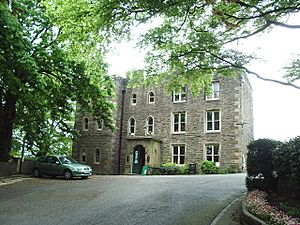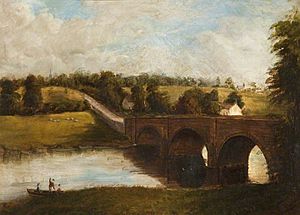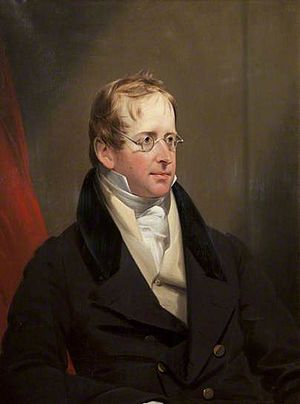Clitheroe Castle Museum facts for kids

Clitheroe Castle Museum in 2007
|
|
| Lua error in Module:Location_map at line 420: attempt to index field 'wikibase' (a nil value). |
The Clitheroe Castle Museum is a cool place to visit in Clitheroe, Lancashire, England. It's inside an old building called the Steward's House. This house was built a long time ago, in the 1700s, for the person who looked after Clitheroe Castle. Today, the museum teaches you all about the history of the local area.
Contents
Discovering Clitheroe's Past
The museum first opened its doors in 1954. It was originally in a different part of the castle grounds, called the Steward's Gallery. Later, it moved into the Steward's House, where it is now.
In 2009, the museum had a big makeover! It cost £3.5 million to make it even better. It reopened on May 23, 2009, and was officially opened by Prince Richard, Duke of Gloucester on June 23, 2009. As part of these changes, a cafe and a shop were added next to the museum. The old Steward's Gallery was also updated to be a special exhibition area.
The museum was recognized as a "Quality Assured Visitor Attraction" in November 2009. This means it's a great place for visitors! The local council, Ribble Valley Borough Council, owns the museum. However, Lancashire County Council helps run it. You only need to pay to enter the museum if you are an adult. The castle grounds themselves are free for everyone to explore.
Inside the Steward's House, you can still see some original features. These include old gas lights, bells that servants used, and fireplaces. It's like stepping back in time!
What You Can See at the Museum
The museum has lots of interesting displays. You can learn about:
- Geology: How the Earth was formed in this area.
- Natural History: The plants and animals that live here.
- Castle History: The story of Clitheroe Castle.
- Local Area: The history of Clitheroe and nearby places.
- Folklore: Old stories and traditions from the area.
- Life in Clitheroe: What life was like for people long ago.
The museum also has special rooms that look like they did in the past.
- The Collector's Study: This room shows what a local collector's study might have looked like. It's based on Frank B. Mitchell, who helped start the museum.
- The Victorian Kitchen: This room shows how kitchens looked during the Victorian era.
You can also see the Mitton Hoard here. This is a collection of old treasures found nearby. The North West Sound Archive used to be on the third floor of the museum. This archive collected old sounds and recordings. It moved to Clitheroe in 1982 but closed in 2015.
Artworks at Clitheroe Castle Museum
The museum displays some cool paintings that tell stories about the area.
The Study Room Paintings
In the "Collector's Study" room, you can find three small paintings of riverside scenes. There's also a special panel called an armorial hatchment.
- Boating at Brungerley by Benjamin Satterthwaite (1848–1923).
This painting shows three people in a boat on the River Ribble. They are near Brungerley Bridge, which is an old stone bridge built around 1814. The bridge connects Waddington and Clitheroe. Benjamin Satterthwaite painted other scenes from this area too.
- Mytton Flatt and River by F.C. Cawthorne.
This painting shows the River Ribble, possibly near Great Mitton. You can see a church in the background that looks like All Hallows Church.
- A Man Fishing on a River. This painting is thought to be by Edward Cawthorne (1849–1914).
It shows a man fishing by a river, probably the River Ribble near Clitheroe. There's a church tower in the background that looks similar to the one in the previous painting.
- General Monk's Hatchment.
This is a special panel with a coat of arms. It belonged to General Monk (1608–1670). He was a soldier who fought in the English Civil War. A hatchment like this would have been hung on a building to let people know that someone important had died.
Inhabiting the Landscape Painting
This section features a painting of a game bird by an artist from Morecambe.
- Grouse Shot in Flight by William Woodhouse (1857–1939).
William Woodhouse was born near Morecambe. He was very good at painting animals, especially horses and dogs. He often painted scenes of hunting, showing game birds and gun dogs. He even had three of his paintings shown at the famous Royal Academy in London.
Industrial Clitheroe Portraits
This section has two portraits by an unknown artist. They show a former Mayor of Clitheroe and his wife.
- James Thomson.
- Cecilia Thomson.
James Thomson (1779–1850) was born in Blackburn. He was a chemist who worked with fabrics. In 1810, he started a very successful business in Clitheroe that printed patterns onto fabric. He was elected a Fellow of the Royal Society in 1821, which is a big honor for scientists. He was also the Mayor of Clitheroe from 1836 to 1837. He passed away in 1850 while getting ready for a big exhibition.



